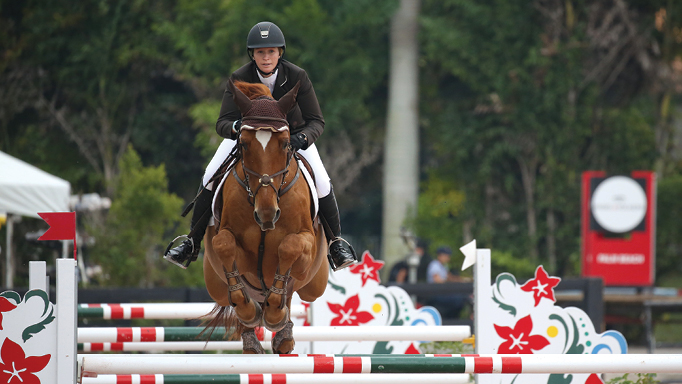The triple combination can be something of a ‘bogey’ for many horses and riders. It is the only place during the course where you have three elements in a row, one or two strides apart. This means that a rider has little space to adjust his or her horse once inside the combination. If you find a less-than-ideal distance to a single fence, or even the first part of a line on course, you usually have multiple strides to react and try to salvage the next distance and element. In the triple, if you find a bad distance in you usually have to perform heroics to get out without faulting.
Additionally, a lot of times triples are set to test your horse’s athletic ability. A horse may be able to jump a huge single oxer, but when it’s the third element of a triple and the first two elements back the horses off so they really have to stretch at the third element, it may be more difficult.
A Giant Gymnastic
I like to think of the triple combination as an oversized gymnastic exercise. It requires balance, collection, and power – all things we hope to achieve when doing gymnastics and grids. The big difference (and why a lot of horses and riders struggle) is that it is usually a lot larger and placed at a point in the course where you have already galloped and made some big efforts, as opposed to cantering to it on its own. Course designers often place the triple after a related distance so a lot can go wrong on your delivery depending on how your horse jumped the previous jump and the distance you have before the triple.
How the triple rides can be very horse-specific. It is important to know your horse’s strengths and weaknesses. Does the horse run through the triple and go past the distance, or does the horse back up and get very careful? Will he be spooky at a particular element in the combination? You should be able to look at the triple and how it is set and know where the ‘test’ is for your horse, which will likely vary from horse to horse. I like to pinpoint my horse’s weakness and practice at home until it is no longer a weakness but a strength, and the triple can really help reveal areas that need work.
Last year, the triple combinations were a huge weakness for me on EH All or None. When I moved up and started jumping bigger classes, I often faulted at the second element and then had trouble jumping the third element when the triple was built vertical, oxer, vertical. I recognized that particular triple made my horse back off and get very careful. I went home and schooled a lot of doubles and triples and I have to say he has jumped the triples very well this year [witness their huge win the CaixaBank Grand Prix at the CSI4* A Coruña in Spain this summer]. I realized my horse had to be quicker and better off my leg if I wanted to be more successful in the triples.
Balance & Control
An exercise that I found very helpful was three small oxers in a row, one stride apart, set at normal distances. As I jumped through, I worked on my horse being in front of me – almost dragging me through. When I started, I had to use a dressage stick and a cluck for encouragement until he carried me through the exercise with very little help from me. We eventually built it bigger and wider once my horse was comfortable. I wouldn’t do this exercise with every horse, because what makes one horse jump better through a triple may cause another horse to fault or become nervous.
It is very important to get to the triple with a good distance and your horse in balance. If a rider is too long and fast into the triple, it is going to be very difficult for the horse to jump it clean. The opposite is also true: if a rider is slow and deep into the triple, the horse may struggle to jump out clean.
The way the course designer builds the triple will influence how a rider rides into the triple and how hard the rider will have to ride in the triple to jump out clean. Usually, if the triple is built related to a previous jump and the distance is long, I like to add a stride. That is something that I have definitely taken away from the European system – doing an extra stride to the triple when it’s possible. Having control and balance jumping into the triple usually increases your odds of jumping B and C clean.

